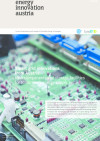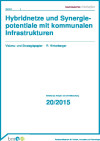Suchergebnisse
Energy services for the optimised summer utilization of district heating systems
Development of practicable energy services for the summer utilization of district heating systems with reference to existing technologies to improve the efficiency and potentialities for the integration of renewable energy.
EnergieRaumPlanung für Smart City Quartiere und Smart City Regionen (ERP_SCQ_SCR)
Das Projekt erforschte in drei österreichischen Stadtregionen (Wien – Niederösterreich, Graz – Steiermark, Vorderland-Feldkirch) Steuerungsansätze mit Energierelevanz, modellierte in Testgebieten Energie-Szenarien zum IST und SOLL und entwickelte daraus übertragbare Handlungsempfehlungen für die Energieraumplanung in Stadtregionen.
Workshop: Roadmap zur integrierten urbanen Solarenergienutzung
3. Oktober 2016
FH Joanneum, Alte Poststraße 154, 8020 Graz
Bei diesem Stakeholderworkshop wird der Entwurf der Roadmap zur integrierten urbanen Solarenergienutzung vorgestellt. Außerdem erhalten Sie als ExpertInnen die Möglichkeit sich in die Gestaltung der Roadmap einzubringen.
Smart grid innovations from Austria

New components and storage facilities for tomorrow‘s energy supply system.
energy innovation austria
2/2018
Herausgeber: BMVIT und Klima- und Energiefonds
Englisch, 8 Seiten
Downloads zur Publikation
CityCalc - Energieplanungs- und Bewertungsinstrument für den Städtebau
Mit CityCalc wurde ein leicht anwendbares Planungs- und Bewertungsinstrument entwickelt, das die energetische Performance von städtebaulichen Projekten bereits in frühen Planungsphasen mit geringem Eingabe- und Bewertungsaufwand beurteilen kann.
Bewertungsmodelle für zukünftige Energiecluster - Fallstudie Biomasse
Marktliberalisierung, die Entwicklung neuer Technologien und die erhöhte Komplexität internationaler Politikprozesse (z. B. Klimapolitik) erfordern Investitionsbewertungsverfahren für neue Energietechnologien, die Unsicherheiten und Risiko entsprechend berücksichtigen. Im Rahmen dieses Projektes wurden Bewertungsmethoden aus der Finanztheorie - wie z. B. Real Options- und Portfoliotheorie verwendet, um die Kompetitivität von Biomasse-Technologieketten (-cluster) und gesamten Energiesystemen zu quantifizieren.
Hybridnetze und Synergiepotentiale mit kommunalen Infrastrukturen

Visions- und Strategiepapier
Schriftenreihe
20/2015
R. Hinterberger
Herausgeber: BMVIT
Deutsch, 39 Seiten
Downloads zur Publikation
SeasonalGridStorage - Innovative saisonale Wärmespeicher für urbane Wärmenetze
Die derzeit in Fernwärmenetzen eingesetzten sensiblen Speicher zur saisonalen Speicherung von überschüssiger Wärme (z.B. Solarthermie, industrielle Abwärme) weisen einen hohen Raumbedarf sowie hohe Investitionskosten und Wärmeverluste auf. In diesem Projekt wurden Konzepte zur Nutzung innovativer Speichertechnologien, wie thermochemische Speicher (TCS) mit hohen Energiedichten und der Möglichkeit der druck- und verlustlosen Speicherung entwickelt und mit Hilfe von Simulationsrechnungen in technischer, ökologischer und wirtschaftlicher Hinsicht untersucht sowie rechtliche Randbedingungen bewertet.
URSOLAR - Optimization of SOLAR energy usage in URban energy systems
URSOLAR provides decision makers with a roadmap for the integrated use of solar energy in urban environments. The roadmap shows, how photovoltaics- and solar-thermal installations can be used in an ecological, economical and socially optimal way whilst considering legal requirements as well as infrastructural conditions in typical city quartiers and stakeholder interests.
Handlungsleitfaden "Gelingensfaktoren zur Energieregion der Zukunft"
Erstellung eines Handlungsleitfaden für die Umsetzung von Initiativen zu Energieregionen der Zukunft; Einbeziehung der Erfahrungen aus den ausgezeichneten Projekten im Wettbewerb, weiterer Projekte und Expertenwissen aus Studien; Verbreitung über Multiplikatoren; Setzen von Verbreitungsmaßnahmen
BIM4BEMS - Building Information Modeling for Building Energy Management Systems
BIM4BEMS explores use cases that represent the usage of building information models (BIM) in combination with building energy management systems (BEMS) during operation. This enables the interaction between BIM and building management systems (BMS) which improves the analysis and visualization of inefficiencies in facilities.
P2H-Pot - Potentials, economic feasibility and system solutions for Power-to-Heat
P2H-Pot has identified economically feasible potentials for Power-to-Heat (P2H) in urban regions. The suitability of different technical system configurations were investigated using thermodynamic simulation and considering experiences from Scandinavian cases. The assessment of short, medium and long term relevance and economic feasibility of P2H were accomplished by simulating model-based scenarios up to 2050 of the Austrian and German electricity and heat market. In cooperation with a district heating company three case studies have been carried out.
Multifunctional Energy Centre Kötschach-Mauthen - model-system to achieve energy-self-sufficiency
Development of concepts for a multifunctional Energy Centre (biomass district heating und biogas polygeneration for the supply of heat, electricity, process heat, cooling and biofuels) and for a "Öko-Energietourismus" for the community of Kötschach-Mauthen on the way to energy-self-sufficiency
Darstellung des effektiven Einsatzes innovativer Bioenergietechnologien im österreichischen Energiesystem der Zukunft (BioEff)

Die Studie zeigt Möglichkeiten und Strategien hinsichtlich des effektiven Einsatzes von innovativen Bioenergietechnologien in Österreich.
Schriftenreihe
73/2023
C. Dißauer, M. Fuhrmann, C. Strasser
Herausgeber: BMK
Deutsch, 112 Seiten
Downloads zur Publikation
Aufbereitung von Biogas zur Einspeisung in das Salzburger Erdgasnetz
Entwicklung einer kostengünstigen und abfallfreien Reinigungseinheit zur Aufbereitung von Biogas auf Erdgasqualität. Schaffung der Grundlage für ein Demonstrationsprojekt einer Biogaseinspeisung in das Salzburger Erdgasnetz.
Energy Performance Contracting (IEA DSM Implementing Agreement - Task X)
The objective of this task within the IEA DSM programme is to facilitate the use of performance contracts and other energy service company (ESCO) contracts. In this scenario, the ESCO has taken on the project's performance risk by guaranteeing a specified level of energy savings. Its compensation for this risk is directly tied to achieving savings. The financing for such a project could come from the ESCO, the equipment supplier or a third-party company.
City Cooling - Intelligent district cooling implementation, Vienna
Development of an intelligent district cooling concept and alternative solutions for heat rejection from central absorption chillers at the example of the neighbourhood TownTown in Vienna.
Synergiepotentiale mit kommunalen Infrastrukturen

Schnittstellen zwischen Energie- und sonstigen Infrastrukturen im Kontext von Hybridnetzen (Factsheet)
Schriftenreihe
23/2015
R. Hinterberger
Herausgeber: BMVIT
Deutsch, 29 Seiten
Downloads zur Publikation
Smart Grids Projects in Austrian R&D Programmes 2003-2010

This publication presents results of projects within the subject area "Smart Grids" in Austrian R&D Programmes 2003-2010. The participating research institutes and companies have achieved many remarkable and internationally acknowledged results.
SUPOSS - Sustainable Power Supply for Supermarkets and Surroundings
Developing technical and business concepts and strategies for a sustainable power supply of supermarkets and local consumers - supply of heat, electric power and cooling energy on the basis of solar energy and solid biomass.
